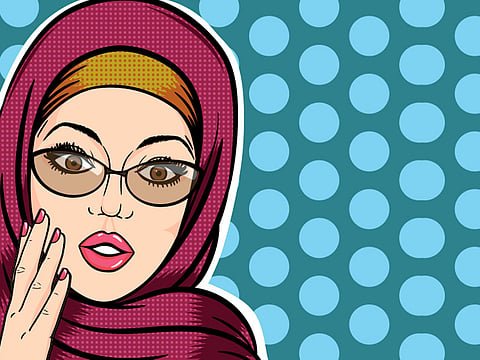Gurl, what do you know about hijab hair woes?
The low-down on how to keep things healthy and fight the frizz under the fabric

With the advent of what marketers call Generation M — a young, trend-loving generation of Muslims — the hijab has emerged both as a symbol of faith and a style statement defining who the women of this age group are and what they stand for.
The hijab is a head covering traditionally worn by some Muslim women in the presence of adult males outside of their immediate family generally for reasons of modesty and privacy.
With nationals from more than 180 countries calling the UAE home, hijab wearers hail from everywhere. But whether Asian, Western, Arab or African, some hair problems are common, and can impact one’s psychological well-being.
The most common hair complaint is dry hair that looks dull and lifeless. This is largely due to hot weather, the use of chemical-laden hair products and not drinking enough water. For others, issues such as dandruff and thinning hair remain unseen.
Maryam Sameer, a 20-yearold Omani national from Sharjah, started wearing a hijab after she got married recently. “When I just started wearing the hijab I struggled with limp hair, breakage and dandruff problems. I noticed if the hijab was too tight, it would pull the front edges of the hair and cause discomfort or breakage. When I removed the hijab my hair was too dry so I started using dry shampoo to breathe life back into my hair.”
Coarser than average
Luckily, salons across the UAE are well equipped to deal with the problem, with years of experience in finding solutions. “Hair that is dryer and coarser than normal needs a lot more moisture to look and stay healthy,” says Aidan Steele, a senior stylist and technician at Toni & Guy Dubai.
Steele often recommends a Brazilian blowout to tame frizz. “At our salon, we use only our in-house product, Label M, as it has UVA and UVB filters that help restore the hair’s integrity.”
As an indication of just how much hair care depends on each individual’s own body chemistry, other women have the opposite problem: an itchy scalp, or hair that is too oily. This is often caused by draping a hijab on wet or damp hair.
Najla Naif Daar Alyafei, a 26-year-old GCC national working as a graphic designer, artist and director in Dubai, has curly hair that is prone to sweat and greasiness after wearing the hijab all day, while the dry weather makes it frizzy.
“To tame my hair, I often use homemade hair masks that are natural and chemical-free,” she explains. “My favorite concoction is a combination of castor and olive oil, which I leave in my hair for six hours once a week. This makes my hair strong and reduces the breakage from using the hijab all day,” she says.
The kind of fabric draped around the head also plays a big role. For example, cotton fabrics help your hair breathe.
RiRi’s fave infusion
Those who choose to go to a clinic may opt for a treatment chosen by Rihanna and Simon Cowell: intravenous vitamin treatments. At the Elixir Clinic, hair infusion injections are the most popular treatment, says Dr Heba Abdelrazek, its medical director. “For these women beauty is a combination of looks and hair, also some of them wear a hijab every day, hence their hair is either damaged or thinning.”
But every Arab grandmother has an arsenal of home remedies for the problem, from castor oil massages to combat hair loss, lemon juice for dandruff and ginger for an itchy scalp, to a diet rich in fruits and vegetables.
Whatever the reason you wear a hijab, there’s no need to let hair problems remain covered.
Sign up for the Daily Briefing
Get the latest news and updates straight to your inbox



